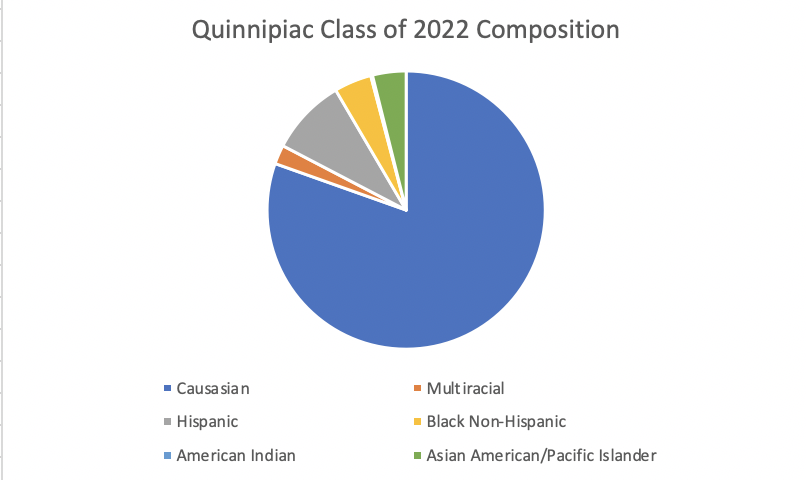Quinnipiac University is trying to shed its image as a predominately white institution but the school still struggles to attract students of color to its Hamden, Connecticut, campus.
Progress, however small, is finally detectable, according to Khalilah Brown-Dean, an associate professor of political science and senior director for inclusive excellence at Quinnipiac.
“The leadership that we have at this university today looks very different from how it looked when I first arrived here,” Brown-Dean said, who is in her ninth year at Quinnipiac. “That’s progress. It may not be progress at the rates some would like, but it is progress.”
That growth is important for the school to achieve its goal of becoming what it describes in its strategic plan as the university of the future. Diversity in leadership is one step in that direction, but what matters more than that is diversity within the student body. That is much harder to attain.
“As the University of the Future,
Quinnipiac’s strategic plan to building an inclusive community and becoming the University of the Future includes the university strengthening its ties to diverse communities.
Quinnipiac will advance its commitment
to inclusive excellence through targeted
efforts in strengthening diverse pipelines
into QU, in transitioning and retaining
nontraditional students and in financial
support for these students. Inclusivity and
excellence will be enhanced through our
curricula, and through the recruitment
and recognition of outstanding faculty
who advance distinctive scholarship and
serve as role models for inclusivity in
our community”
Via https://www.qu.edu/about-quinnipiac/strategic-plan.html
Black students at Quinnipiac represent just 4.12% of the Class of 2022, for example, which has 1,895 students, according to the school’s website.


First-year journalism major and Class of 2024 vice president Olivia Barrios-Johnson said she believes that Quinnipiac’s growth in Black leadership will help to attract Black students who will see themselves as someday working in the leadership suite.
“I think it’s important for students to see multicultural professors and have people to look up to,” Barrios-Johnson said. “Sometimes I am the only Black girl in my classes or my Zoom calls and it can be a little intimidating and it can make me a little nervous to speak out sometimes because I don’t know how others in the room may take my opinion.”
That fear is real and keeps some students from participating in discussions at a school where 75% of the study body is white. Just ask Toyloy Brown III, a junior journalism major from The Bronx, New York. He attended primary and secondary schools with multiracial and multicultural classes. He found the opposite when he enrolled at Quinnipiac.

“The first class I had I was the only Black student. The professor goes through attendance and they don’t even have to call my name because they can easily spot me,” Brown said.
The sheer Whiteness of Quinnipiac makes it difficult to retain Black students. That’s where student organizations come into play to help students make friends. Senior finance major Gaethan Lucien points to the Black Student Union (BSU), the African and Caribbean Student Union (ACSU), the Latino Cultural Society and other organizations as vital to retaining students of color.

“They are extremely important. These organizations provide a home on campus for minority students like myself. Quinnipiac needs to continue to support these organizations to the fullest in order to increase their diversity rate,” Lucien said.
The school’s multicultural suite is another place where students of color and white students can gather and exchange perspectives.
“I think it’s important for students to feel connected to their campus,” said Brown-Dean. “To feel a part of a community. To feel that they can be themselves and express concerns that they have. To experience joy they are feeling, but to also feel that they are seen,” Brown-Dean said.
Senior class president Olamide Gbotosho has mixed feelings about the multicultural suite.
“I think the multicultural suite is both positive and negative, in my opinion,” said Gbotosho. “Positive because mostly people of color go into that suite and they’re able to learn from each other and able to hang out with people that look like them. I think that also allows them to be more comfortable with only staying with those kinds and not going out to other [organizations] and doing other things. So, then it creates this bubble of people of color and then another bubble of people that are not people of color.”

Gbotosho said that she has seen an increase in involvement since her first year at Quinnipiac in 2017. More students than ever are joining the BSU, ACSU and similar clubs, but Gbotosho said it’s important to maintain recruiting to keep the groups thriving.
That growth in involvement does not stop at the student level. The work that faculty and staff are putting in to grow the Black community and promote inclusive excellence has also grown in recent years. Years of preparation have come to fruition as Quinnipiac published a 10-point action plan to combat racial injustice on campus. Brown-Dean says that while these actions are just now being put into effect, the paving of this path to justice has been going on for years.
“There have to be multiple ways to approach the same problem. We didn’t get here overnight, and we won’t completely transform the culture of campus and community overnight,” Brown-Dean said.
“The 10-point plan is built on work that was already being done. Expanding on that work and who was involved in the work, while still being nimble enough to respond to the ever changing needs that were being raised,” Brown-Dean said.
Vice president for equity and inclusion at Quinnipiac Donald Sawyer III sees a change happening on campus. Sawyer, who is in his eighth year at QU says growth cannot happen without retention.
“Let people know that they are seen, that they are heard and that they matter at your institution,” said Sawyer. “That’s for faculty, staff and students. How do you let people know that they matter and that they belong here and are included as a member of the community?”
Beyond fitting in, Sawyer says opportunities to grow are imperative to retaining faculty. A main focus of the university is developing pipelines for recruiting diverse faculty. Once that faculty is recruited, Sawyer says they are working on ways to expand their experiences at Quinnipiac.
“Part of retention is having opportunities for growth,” said Sawyer. “You come into the institution at an entry level position, after a while if you’re not seeing places where you can go then it will be more likely for that person to leave because you want to move up in your career.”
Brown-Dean is aware that a culture of inclusivity cannot be created overnight and that there will be obstacles at every step of the way.
“There have to be multiple ways to approach the same problem. We didn’t get here overnight, and we won’t completely transform the culture of campus and community overnight,” Brown-Dean said.
Brown-Dean said she believes Quinnipiac needs to recruit more Black faculty and staff, and even though the school has more Black employees than it did a decade ago, recruiting efforts need to be stepped up to achieve true diversity.
“How do we move from the plan to action? We are looking at our pipelines. How do we recruit a more diverse faculty? How do we diversify our staff,” said Brown-Dean when referencing her goals in recruiting and retaining Black leaders. Students agreed. They said that attending a class taught by someone who looks like them is meaningful and motivating.
“Hiring more faculty of color is definitely something that I think the university is working towards, because I do think that it makes a big difference. Growing up I barely had Black teachers and still now in college,” Barrios-Johnson said.
Toyloy Brown echoed Barrios-Johnson in the need to recruit more Black faculty.
“I know there’s Black faculty out there but there’s just not that many that we see,” Brown said.
“I had two black professors and my experiences in these classes were certainly better than the others because I was being taught by someone I could relate to,” Lucien said.
“You can’t become the university of the future unless you acknowledge the history of your university,” Brown-Dean said.
Quinnipiac has grown from a school of less than 6,000 at the turn of the century to one of 10,000 students, spread across three campuses. If the university wants to continue to grow as the 21st century deepens, it will have to follow the advice of Gbotosho.
“Student leaders are coming together more, which I find really inspiring because it is leading the way for Quinnipiac of the future,” Gbotosho said.
Brown-Dean knows that the goal is clear.
“You can’t become the university of the future unless you acknowledge the history of your university,” Brown-Dean said.

